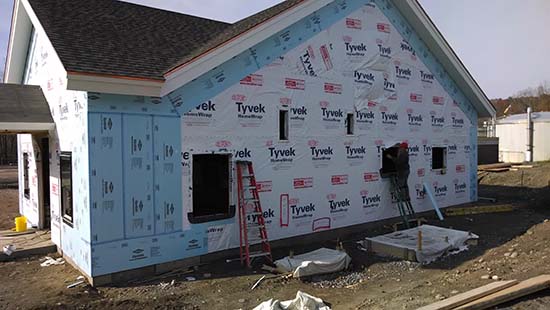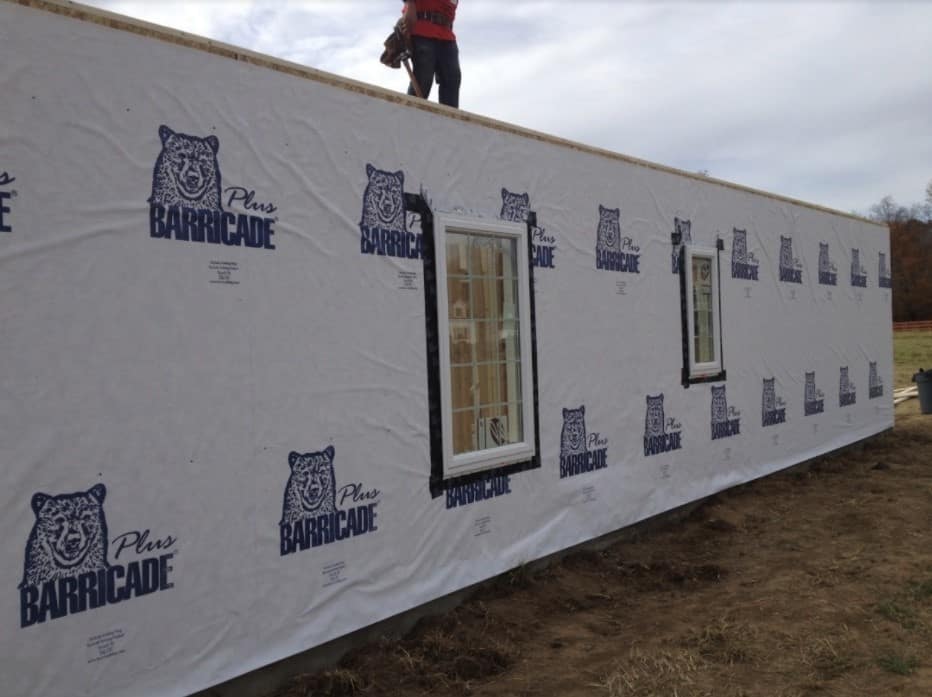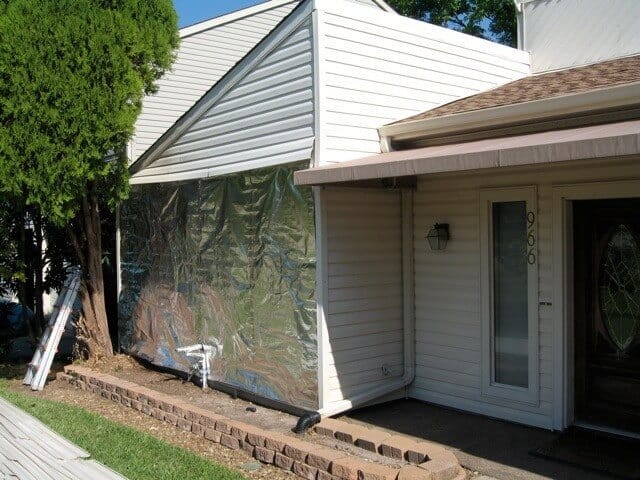Are you considering skipping house wrap for your vinyl siding installation project? Vinyl has many great benefits, water resistance being one among them. But, the gaps and joints on the siding can let in moisture, increasing the risk of water damage to your walls.
In this article, we’ll talk about why you need house wrap behind vinyl siding and the few instances where you might not need a moisture barrier. We’ll also dispel a few myths about house wrap, helping you make smart decisions when undertaking your vinyl siding project.
Table of Contents
- What Is House Wrap and How Does It Work?
- Is It Mandatory To Install House Wrap Behind Vinyl Siding?
- Why Do You Need To Install House Wrap Behind Vinyl Siding?
- 4 Common Myths on Installing House Wrap Behind Vinyl
- Is House Wrap Expensive?
- How Hard Is It To Install House Wrap?
- Does House Wrap Affect Ventilation?
- Does House Wrap Cause Mold Or Mildew?
- Summary: Do I Need House Wrap Behind Vinyl Siding?
What Is House Wrap and How Does It Work?

House wrap is a water-resistive barrier (WRB) that keeps moisture from penetrating the house and allows vapor to escape, leaving the walls dry and lowering the risk of water damage.
There are many types of moisture barriers, including felt paper, polyolefin fabric wrap made from polypropylene or polyethylene fibers, asphalt felt, kraft paper reinforced with asphalt, rigid form, and WRB sheathing. Modern house wrap is typically made out of plastic fabric and branded under different names.
House wrap contains small holes that are impervious to water. Heavy rains may seep through the vinyl siding but will not penetrate the walls when your building is covered with house wrap.
The perforations are small enough to keep water away and big enough to allow vapor to escape. As such, any moisture inside your home can easily be diffused through the house wrap. So, you do not have to worry about the wrap forming a tight barrier that will keep your house too moist for your liking.
Is It Mandatory To Install House Wrap Behind Vinyl Siding?
There are no specific laws or building codes requiring homeowners to install house wrap behind siding. So, in a way, you can get away with not wrapping your house in a protective waterproof barrier. But, the benefits of house wrap far outweigh the downsides.
Some homeowners wrongly believe they can save on costs by skipping house wrap when installing vinyl siding. The average cost of this protective barrier is $0.4-$0.6 per square foot, which would amount to about $1,000 for most homes. This is a negligible cost to pay compared to the immense benefits you get from installing the material.
House wrap is not always mandatory, but it is necessary if you care about your home’s structural longevity. Next, let us look at the benefits of installing house wrap and the risks involved if you skip this important part of the vinyl installation process.
Why Do You Need To Install House Wrap Behind Vinyl Siding?

Whether installing siding on an older house or a new build, you should factor in house wrap installation.
The main benefits of house wrap are:
- Protection against mold and mildew
- Reduces the risk of water damage
- Enhance energy efficiency
- Improve resale value
Protection against mold and mildew
House wrap will not resolve an existing mold or mildew problem, but it can prevent it from occurring in the first place. Mold and mildew thrive in moist places and spread quickly. If you live in a humid or wet region, moisture is highly likely trapped behind your siding. This moisture should not be a problem for homes with house wrap, as the protective barrier will protect the walls, keeping away mold and mildew damage.
Reduces the risk of water damage
Mold and mildew are not the only risks you face when your walls are not barricaded against moisture. Rot and rust can also occur, discoloring the vinyl siding and forcing you to install new vinyl.
Fixing water damage can be very expensive. Sometimes, you may need to replace the entire wall and vinyl sidings, depending on the extent of the damage. If you notice water seeping out through the siding, the chances are good that the house does not have a moisture-resisting barrier installed.
Installing house wrap is a simple and affordable solution that can save you money on repairs and touch-ups to a water-damaged wall with no house wrap.
Enhance Energy Efficiency
House wrap is very good at keeping moisture away but is a poor material for conducting heat. Although the water-resistive barrier does not fully insulate the house, it does offer some insulation against heat loss from your house.
People in colder climates will find it particularly advantageous to install house wrap as an extra layer of insulation against heat loss.
House wrap seals leaky spots in the house, slowing down the rate at which air escapes. In colder weather, your house will retain heat, and you will spend less energy keeping the house warm and comfortable.
There is quite a difference in the amount of energy used to keep the house warm without house wrap. This may translate into higher energy bills.
High energy consumption per household has a big impact on the environment too. You can play your part and lower your carbon footprint by insulating your house against unnecessary heat loss.
Improve Your Home’s Resale Value
You should install house wrap behind vinyl siding, especially if you live in a cold climate. The additional layer of protection against moisture and unnecessary heat loss can make your house attractive to potential buyers.
Even if you are not selling, house wrap will not take away any points from the value of your house. The protection against rot damage, mold, and mildew ensure that your house stays structurally strong for longer.
In addition, by installing house wrap, you will save on regular repairs and replacements, whose costs can add up fast.
As you can see, house wrap has many excellent benefits. Next, I would like to bust some common myths about house wrap.
4 Common Myths on Installing House Wrap Behind Vinyl

Are common myths deterring you from installing house wrap? It is time to bust the myths to help you make more informed decisions. Some common misconceptions are:
- House wrap is expensive
- House wrap is hard to install
- House wrap causes ventilation problems
- House wrap causes mold and mildew
Is House Wrap Expensive?
The cost of installing a protective moisture barrier behind the siding will depend on several factors. Labor, cost of material, and taxes will all add to the final installation cost.
On average, you can expect to pay between $0.4 and $0.6 per square foot of house wrap. Installation costs typically range between $250 and $900, depending on your locality.
The damage your house can potentially incur from mold, mildew, and rot is far greater than the cost of installing house wrap. When properly installed, house wrap can last for many years, from a one-time installation.
How Hard Is It To Install House Wrap?
You might consider skipping the house wrap for fear that it will take up all your time. The truth is, you do not need to be a pro to install house wrap.
If your DIY skills are good enough, have the right tools, and can read and follow instructions, then you should be able to wrap your house with a moisture barrier.
Depending on the size of your house, the project may take 1 or 2 days. That said, if you are looking to wrap a large house, I recommend consulting with a contractor to ensure the best results for such a project.
Does House Wrap Affect Ventilation?
House wrap is plastic, so it can prevent the house from ‘breathing,’ right? This is not true at all, and it should not prevent you from wrapping your house.
House wrap is designed to be impervious to water, but it can let out vapor. This means that at no time will your house not breathe and therefore hold too much moisture. The vapors and gases the house produces are let out through the house wrap to the outdoor air.
Does House Wrap Cause Mold Or Mildew?
In some circles, it is believed that wrapping your house can expose it to mold or mildew because the wrap traps mildew. This could not be further from the truth!
The perforations on house wrap allow vapor to dissipate to avoid trapping any of it in the house or behind the siding
That said, poor installation can lead to ventilation and moisture problems, which increases the risk of mold and mildew. If you are unsure of your DIY skills, it is best to leave house wrap installation to the experts.
Summary: Do I Need House Wrap Behind Vinyl Siding?
Even if your local building codes do not require it, installing house wrap behind vinyl siding is one of the best decisions you can make to protect the longevity and value of your home.
You should strongly consider wrapping your house if you live in a windy or rainy area, want to improve your home’s energy efficiency, and if mold and mildew have been a problem in your area. Of course, if mold is already present on your walls, you should have a professional remove it before installing a moisture barrier.